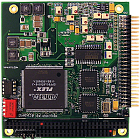 DM6430HR
True AT High Speed dataModule
The DM6430 analog I/O dataModule® turns your IBM AT‑compatible cpuModule or other PC/104 computer into a high-speed, high-performance data acquisition and control system.
DM6430HR
True AT High Speed dataModule
The DM6430 analog I/O dataModule® turns your IBM AT‑compatible cpuModule or other PC/104 computer into a high-speed, high-performance data acquisition and control system.
 IPWR104HR
100 Watt Isolated Embedded Power Supply
The RTD IPWR104HR embedded power supply module provides an elegant solution for PC/104 systems requiring an isolated reliable power supply. The two available wide input voltage ranges of 18 - 36V and 33 - 75V will suit applications ranging from communications to aviation.
The IPWR104HR is available with a wide operating temperature range of -40 to +85 C. Power from the module is delivered to the PC/104 bus as well as to the card edge terminal blocks. Output voltages include +5 at 12A/20A, +12V at 2.0A and -12V at 500mA (100 Watt maximum combined output). These outputs are connected to the PC/104 bus as well as terminal blocks.
IPWR104HR
100 Watt Isolated Embedded Power Supply
The RTD IPWR104HR embedded power supply module provides an elegant solution for PC/104 systems requiring an isolated reliable power supply. The two available wide input voltage ranges of 18 - 36V and 33 - 75V will suit applications ranging from communications to aviation.
The IPWR104HR is available with a wide operating temperature range of -40 to +85 C. Power from the module is delivered to the PC/104 bus as well as to the card edge terminal blocks. Output voltages include +5 at 12A/20A, +12V at 2.0A and -12V at 500mA (100 Watt maximum combined output). These outputs are connected to the PC/104 bus as well as terminal blocks.
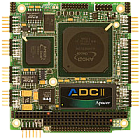 CME136686LX333HR/500HR
PC/104 Ultra Low Power cpuModule & Controller with Advanced Digital I/O (aDIO)
RTD's CME136686LX cpuModule represents the latest in reliable low-power performance embedded computing solutions. It includes a 500 or 333MHz AMD Geode LX processor with 128kB L1 cache (64kB instruction and 64kB data) and 128kB L2 cache. It uses a 333MHz DDR-SDRAM controller that can support up to 2.7 G-Bytes per second of memory bandwidth.
The video interface is provided by an Analog SVGA output and an LVDS flat panel output. The two outputs are independent, and can display separate images and display timings. Maximum resolution is 1920 x 1440.
High-speed peripheral connections include USB 2.0, with up to 480 Mb/sec data throughput. An ATA-100/66/33 IDE controller provides a fast connection to the hard drive. Network connectivity is provided by an Intel 82551QM Ethernet controller. Network connectivity is provided by two Intel 82551QM Ethernet controllers. Other features include two RS-232/422/485 COM ports (four ports if in dual-port mode), and Parallel Port.
RTD has gone the extra mile to include additional advanced features for maximum flexibility. These include an ATA/IDE Disk Chip socket that allows a true IDE drive to be attached to the board, either socketed or soldered. A multiPort can be configured as a standard EPP/ECP parallel port, a floppy drive port, or an Advanced Digital I/O (aDIO) port. SDRAM is soldered directly to the board for high vibration resistance. The CME136686LX is also available in a rugged, fanless IDAN enclosure.
CME136686LX333HR/500HR
PC/104 Ultra Low Power cpuModule & Controller with Advanced Digital I/O (aDIO)
RTD's CME136686LX cpuModule represents the latest in reliable low-power performance embedded computing solutions. It includes a 500 or 333MHz AMD Geode LX processor with 128kB L1 cache (64kB instruction and 64kB data) and 128kB L2 cache. It uses a 333MHz DDR-SDRAM controller that can support up to 2.7 G-Bytes per second of memory bandwidth.
The video interface is provided by an Analog SVGA output and an LVDS flat panel output. The two outputs are independent, and can display separate images and display timings. Maximum resolution is 1920 x 1440.
High-speed peripheral connections include USB 2.0, with up to 480 Mb/sec data throughput. An ATA-100/66/33 IDE controller provides a fast connection to the hard drive. Network connectivity is provided by an Intel 82551QM Ethernet controller. Network connectivity is provided by two Intel 82551QM Ethernet controllers. Other features include two RS-232/422/485 COM ports (four ports if in dual-port mode), and Parallel Port.
RTD has gone the extra mile to include additional advanced features for maximum flexibility. These include an ATA/IDE Disk Chip socket that allows a true IDE drive to be attached to the board, either socketed or soldered. A multiPort can be configured as a standard EPP/ECP parallel port, a floppy drive port, or an Advanced Digital I/O (aDIO) port. SDRAM is soldered directly to the board for high vibration resistance. The CME136686LX is also available in a rugged, fanless IDAN enclosure.
 Model 812
8-Channel Frame Grabber
Sensoray Model 812 is an 8-channel PCI-Express frame grabber that can simultaneously capture 8 channels of NTSC/PAL video, plus optional 8 channels of mono audio. Each video channel captures at full frame rate 30 fps (for NTSC) or 25 fps (for PAL), which results in an aggregate frame rate of up to 240 fps (for NTSC) or 200 fps (for PAL). The board implements a single-lane (x1) PCI-Express interface that enables it to be plugged into any width of PCI-Express slots. All operating power is supplied from the PCI-Express bus and no external power supply is needed.
One model 812C1 cable (shown in image) is included with model 812, which can be used to connect eight video signals or eight audio signals to the board. In applications that require both audio and video inputs, an additional 812C1 cable should be purchased separately.
Video
All 8 composite video inputs are connected through a DB15 connector with a DB15-to-BNC breakout cable. An additional 34-pin connector can be used for breaking in the all composite video input signals as well. The video capture resolution can be chosen from D1, VGA, QVGA, CIF, 4CIF, SIF, 4SIF, etc. Captured frames could be in YUYV, UYVY, RGB555, or RGB565 formats.
Audio
All 8 mono audio inputs can be connected through a second DB15 connector with an optionally supplied DB15-to-BNC breakout cable. The 34-pin connector can be used for breaking-in the all audio input signals too. The audio sampling rate could be at 8K, 16K, 32K, 44.1K, or 48K Hz.
Digital I/Os
8 general-purpose digital I/O (DIO) signals are provided for camera control, status indication, or alarming, etc. They can be configured to function as inputs or outputs.
Software
A Software Development Kit (SDK) is currently available for Linux and an SDK for Windows is coming soon. The SDKs include drivers, programming samples, and comprehensive documentation to help users/programmers to quickly start and develop custom applications using the Model 812.
Applications
Sensoray Model 812 is designated for video surveillance applications. However, it can be used for all other multi-channel vision, image processing, and video capturing + recording applications. With chipset supplier's expectation, all video source signals are expected from stable video sources. The board is not suitable for week video signal sources and/or switching video source applications. To get better multi-channel perview performance on PCs with an Intel shipset, a discrete (non on-motherboard) graphic video card might be needed.
Model 812
8-Channel Frame Grabber
Sensoray Model 812 is an 8-channel PCI-Express frame grabber that can simultaneously capture 8 channels of NTSC/PAL video, plus optional 8 channels of mono audio. Each video channel captures at full frame rate 30 fps (for NTSC) or 25 fps (for PAL), which results in an aggregate frame rate of up to 240 fps (for NTSC) or 200 fps (for PAL). The board implements a single-lane (x1) PCI-Express interface that enables it to be plugged into any width of PCI-Express slots. All operating power is supplied from the PCI-Express bus and no external power supply is needed.
One model 812C1 cable (shown in image) is included with model 812, which can be used to connect eight video signals or eight audio signals to the board. In applications that require both audio and video inputs, an additional 812C1 cable should be purchased separately.
Video
All 8 composite video inputs are connected through a DB15 connector with a DB15-to-BNC breakout cable. An additional 34-pin connector can be used for breaking in the all composite video input signals as well. The video capture resolution can be chosen from D1, VGA, QVGA, CIF, 4CIF, SIF, 4SIF, etc. Captured frames could be in YUYV, UYVY, RGB555, or RGB565 formats.
Audio
All 8 mono audio inputs can be connected through a second DB15 connector with an optionally supplied DB15-to-BNC breakout cable. The 34-pin connector can be used for breaking-in the all audio input signals too. The audio sampling rate could be at 8K, 16K, 32K, 44.1K, or 48K Hz.
Digital I/Os
8 general-purpose digital I/O (DIO) signals are provided for camera control, status indication, or alarming, etc. They can be configured to function as inputs or outputs.
Software
A Software Development Kit (SDK) is currently available for Linux and an SDK for Windows is coming soon. The SDKs include drivers, programming samples, and comprehensive documentation to help users/programmers to quickly start and develop custom applications using the Model 812.
Applications
Sensoray Model 812 is designated for video surveillance applications. However, it can be used for all other multi-channel vision, image processing, and video capturing + recording applications. With chipset supplier's expectation, all video source signals are expected from stable video sources. The board is not suitable for week video signal sources and/or switching video source applications. To get better multi-channel perview performance on PCs with an Intel shipset, a discrete (non on-motherboard) graphic video card might be needed.
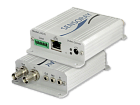 Model 2453/2454
IP Video Encoder/Decoder Server
Model 2453 is a compact IP video server that captures and compresses analog audio and NTSC/PAL video and sends the resulting streams over Ethernet. It can simultaneously produce two output streams with independent resolutions, frame rates, and bit rates, allowing it to be easily tailored to match network capabilities and application requirements. It provides a number of advanced features including deinterlacing with motion artifact removal, real-time text overlay, and image rotation and mirroring.
Video can be output as an elementary stream or multiplexed. A variety of stream formats are supported, including MPEG-4 (.m4v) and H.264 (.264 or .h264) elementary streams, MP4 (.mp4) and MPEG-2 transport stream (.ts) containers, and MJPEG (.mjpg or .mjpeg). The transport stream uses AAC audio and H.264 or MPEG-4 ASP video.
The overlay generators can position up to 160 characters of text anywhere in the video frame. A unique text string, consisting of mixed constant and variable text, may be defined for each overlay generator. Text variables such as time, date, and frame count are automatically updated every video frame.
A flexible serial port, configurable as RS232, RS422 or RS485 is provided for camera PTZ control or general-purpose use. Several other peripherals can be easily added with an optional 2453TAS board:
One digital input and one output, useful for alarms, lighting control or general purpose use. The output is optically isolated and the input may be optically isolated or galvanically coupled.
A host USB port for connection to external storage or wireless LAN.
An SD card socket that allows a removable flash card to serve as local storage for captured video and audio — useful for mitigating network congestion problems when data losses are unacceptable or for gapless monitoring during closed network access windows.
A battery that enables retention of date and time when the unit is not powered.
Model 2453 can also perform as a decoder, receiving a compressed audio/video stream over the network and converting it to standard analog video and audio signals (decoding is guaranteed only for streams captured with the 2453).
The built-in web server allows device configuration and control, user management, and live stream previewing on any web browser.
Customization of the 2453 user interface is easy. Controls that are not required can be hidden and page headers can be replaced with custom graphics. See the instructions for complete details.
Model 2453 is available in four configurations:
2453TAS — model 2453 + model 2453TA in metal enclosure;
2453S — model 2453 is in a low-profile metal enclosure;
2453 — a board version;
A miniature version of the product, model 2454, weighing less than one ounce, provides the same functionality as model 2453 using high density headers instead of standard connectors.
Model 2453/2454
IP Video Encoder/Decoder Server
Model 2453 is a compact IP video server that captures and compresses analog audio and NTSC/PAL video and sends the resulting streams over Ethernet. It can simultaneously produce two output streams with independent resolutions, frame rates, and bit rates, allowing it to be easily tailored to match network capabilities and application requirements. It provides a number of advanced features including deinterlacing with motion artifact removal, real-time text overlay, and image rotation and mirroring.
Video can be output as an elementary stream or multiplexed. A variety of stream formats are supported, including MPEG-4 (.m4v) and H.264 (.264 or .h264) elementary streams, MP4 (.mp4) and MPEG-2 transport stream (.ts) containers, and MJPEG (.mjpg or .mjpeg). The transport stream uses AAC audio and H.264 or MPEG-4 ASP video.
The overlay generators can position up to 160 characters of text anywhere in the video frame. A unique text string, consisting of mixed constant and variable text, may be defined for each overlay generator. Text variables such as time, date, and frame count are automatically updated every video frame.
A flexible serial port, configurable as RS232, RS422 or RS485 is provided for camera PTZ control or general-purpose use. Several other peripherals can be easily added with an optional 2453TAS board:
One digital input and one output, useful for alarms, lighting control or general purpose use. The output is optically isolated and the input may be optically isolated or galvanically coupled.
A host USB port for connection to external storage or wireless LAN.
An SD card socket that allows a removable flash card to serve as local storage for captured video and audio — useful for mitigating network congestion problems when data losses are unacceptable or for gapless monitoring during closed network access windows.
A battery that enables retention of date and time when the unit is not powered.
Model 2453 can also perform as a decoder, receiving a compressed audio/video stream over the network and converting it to standard analog video and audio signals (decoding is guaranteed only for streams captured with the 2453).
The built-in web server allows device configuration and control, user management, and live stream previewing on any web browser.
Customization of the 2453 user interface is easy. Controls that are not required can be hidden and page headers can be replaced with custom graphics. See the instructions for complete details.
Model 2453 is available in four configurations:
2453TAS — model 2453 + model 2453TA in metal enclosure;
2453S — model 2453 is in a low-profile metal enclosure;
2453 — a board version;
A miniature version of the product, model 2454, weighing less than one ounce, provides the same functionality as model 2453 using high density headers instead of standard connectors.
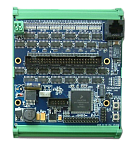 Model 2410
48-Channel Digital I/O Interface
Model 2410 is a compact open-frame module that interfaces 48 general-purpose TTL/CMOS compatible digital input/output (DIO) signals to a 10/100 Mbps Ethernet. It features advanced signal processing functions that reduce the host computer’s burden in measurement and control applications.
The module communicates through its built-in web and telnet servers, using telnet for automation applications and an embedded web site for configuration, manual control, and diagnostics. Precompiled API libraries are provided for Linux and Windows, along with open source (C language) code to enable porting and customization.
The unit has a small footprint, requires only a single 24VDC power source, and can be quickly and easily mounted by snapping it onto a standard DIN mounting rail. It will interface directly to many standard solid state relay racks, and it has an auxiliary power output that is capable of supplying 5VDC power to solid state relay racks or other modest external loads.
DIO Functions
Each open-collector DIO channel can operate as an input, an output, or in wired-or mode. A number of special functions such as debounce, edge detection, and PWM output, are available on each channel. All channels are synchronized to a common 1KHz clock to guarantee true state machine behavior. An LED indicates each channel’s physical state.
Software debounce can be enabled for any input signal, with debounce interval ranging from 0 to 255 milliseconds. Also, edge detection and capture may be enabled for any input signal and, if desired, asynchronous notification messages (i.e., «interrupts») will be sent to an Ethernet client when edge events are captured.
Outputs are capable of 24mA active-low output drive, and internal pull-up resistors are provided for all channels. Each output channel may be independently configured to function in the conventional fashion (directly controlled by Ethernet clients) or as a PWM generator with one millisecond resolution.
Signal Connections
A standard 50 pin header is provided for connecting the module to external solid-state relay racks or custom OEM signal distribution systems.
Sensoray also offers an optional termination board, Model 2410TA, which can be top-mounted to the module to add convenient field wiring terminal blocks without enlarging the module’s footprint. The spring-loaded terminals allow quick connection of 24-16 gauge wires.
LabVIEW Demo
In addition to the standard API, Sensoray provides a LabVIEW application which demonstrates how to interact the 2410.
Model 2410
48-Channel Digital I/O Interface
Model 2410 is a compact open-frame module that interfaces 48 general-purpose TTL/CMOS compatible digital input/output (DIO) signals to a 10/100 Mbps Ethernet. It features advanced signal processing functions that reduce the host computer’s burden in measurement and control applications.
The module communicates through its built-in web and telnet servers, using telnet for automation applications and an embedded web site for configuration, manual control, and diagnostics. Precompiled API libraries are provided for Linux and Windows, along with open source (C language) code to enable porting and customization.
The unit has a small footprint, requires only a single 24VDC power source, and can be quickly and easily mounted by snapping it onto a standard DIN mounting rail. It will interface directly to many standard solid state relay racks, and it has an auxiliary power output that is capable of supplying 5VDC power to solid state relay racks or other modest external loads.
DIO Functions
Each open-collector DIO channel can operate as an input, an output, or in wired-or mode. A number of special functions such as debounce, edge detection, and PWM output, are available on each channel. All channels are synchronized to a common 1KHz clock to guarantee true state machine behavior. An LED indicates each channel’s physical state.
Software debounce can be enabled for any input signal, with debounce interval ranging from 0 to 255 milliseconds. Also, edge detection and capture may be enabled for any input signal and, if desired, asynchronous notification messages (i.e., «interrupts») will be sent to an Ethernet client when edge events are captured.
Outputs are capable of 24mA active-low output drive, and internal pull-up resistors are provided for all channels. Each output channel may be independently configured to function in the conventional fashion (directly controlled by Ethernet clients) or as a PWM generator with one millisecond resolution.
Signal Connections
A standard 50 pin header is provided for connecting the module to external solid-state relay racks or custom OEM signal distribution systems.
Sensoray also offers an optional termination board, Model 2410TA, which can be top-mounted to the module to add convenient field wiring terminal blocks without enlarging the module’s footprint. The spring-loaded terminals allow quick connection of 24-16 gauge wires.
LabVIEW Demo
In addition to the standard API, Sensoray provides a LabVIEW application which demonstrates how to interact the 2410.
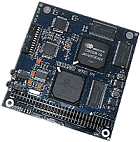 Model 516
MPEG-2/1 Frame Grabber and Video Encoder/Decoder
Model 516 is a PC/104 frame grabber that captures and transfers full-frame (640 x 480) video at 30 frames per second. It overcomes the low bandwidth of the PC/104 bus by using hardware compression to produce encoded MPEG-2 and MPEG-1 data streams of 440 kbits to 10 Mbits per second. It also has two audio input channels that are synchronized to the MPEG data.
Advantages
MPEG2 data reduces the amount of memory required to store full motion video. The compressed data requires a smaller transmission bandwidth. This makes it possible to transmit 30 frames/sec video and audio over the PC/104 bus or over a 10/100 Base-T Ethernet. The hardware compression circuit uses a motion estimation algorithm to produce smooth images from interlaced cameras. The length of MPEG2 video streams is not limited by the viewing software.
Decompression
Encoded MPEG2 data can also be decompressed by the 516’s hardware to produce composite video and audio. The video output is available at a flat cable header. The audio output is available at an audio jack and the flat cable header.
Video channels
The 516 has four multiplexed video channels that function as four separate composite channels or as two S-video inputs. Only one channel can be compressed at a time
Digital I/O
Two bi-directional logic lines are under software control.
Text caption buffer
A 64 character buffer is available for adding text to each frame. The text is within a transparent box that may be positioned anywhere within the frame.
Self test
Digitized video and audio inputs can be looped back to the output circuits to allow camera and sound adjustments. The 516’s D/A can be programmed to generate color test bars. This is useful for testing the video output channel.
Lost video detection
The status of the camera’s vertical and horizontal sync signals may be used to detect the presence or absence of the camera signal. The included software allows reading these signals to detect a lost video signal.
Model 516
MPEG-2/1 Frame Grabber and Video Encoder/Decoder
Model 516 is a PC/104 frame grabber that captures and transfers full-frame (640 x 480) video at 30 frames per second. It overcomes the low bandwidth of the PC/104 bus by using hardware compression to produce encoded MPEG-2 and MPEG-1 data streams of 440 kbits to 10 Mbits per second. It also has two audio input channels that are synchronized to the MPEG data.
Advantages
MPEG2 data reduces the amount of memory required to store full motion video. The compressed data requires a smaller transmission bandwidth. This makes it possible to transmit 30 frames/sec video and audio over the PC/104 bus or over a 10/100 Base-T Ethernet. The hardware compression circuit uses a motion estimation algorithm to produce smooth images from interlaced cameras. The length of MPEG2 video streams is not limited by the viewing software.
Decompression
Encoded MPEG2 data can also be decompressed by the 516’s hardware to produce composite video and audio. The video output is available at a flat cable header. The audio output is available at an audio jack and the flat cable header.
Video channels
The 516 has four multiplexed video channels that function as four separate composite channels or as two S-video inputs. Only one channel can be compressed at a time
Digital I/O
Two bi-directional logic lines are under software control.
Text caption buffer
A 64 character buffer is available for adding text to each frame. The text is within a transparent box that may be positioned anywhere within the frame.
Self test
Digitized video and audio inputs can be looped back to the output circuits to allow camera and sound adjustments. The 516’s D/A can be programmed to generate color test bars. This is useful for testing the video output channel.
Lost video detection
The status of the camera’s vertical and horizontal sync signals may be used to detect the presence or absence of the camera signal. The included software allows reading these signals to detect a lost video signal.
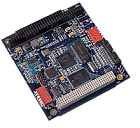 Model 314
MPEG-4/2/1 and MJPEG Frame Grabber
Model 314 is a low-cost MPEG-4/2/1 and MJPEG frame grabber that captures full-frame (720 x 480) video at 30 frames per second. Uncompressed video is available through the PC/104+ bus for previewing. It also has two synchronized audio input channels and on screen display of text (OSD).
Advantages of compression
MPEG and MJPEG data reduces the amount of memory required to store full motion video. The compressed data requires a smaller transmission bandwidth. MJPEG data is typically compressed by a factor 20 while MPEG-2 and -4 by a factor of 100. Image compression makes it possible to transmit 30 frames/sec of MPEG video over the PC/104+ bus. The hardware compression circuit uses a motion estimation algorithm to produce smooth images from interlaced cameras.
Uncompressed capture
The 314 can function as a conventional frame grabber by supplying uncompressed video with low latency and snapshots of single frames. A lower cost version, 314NC, is available without the compression circuitry and the on screen display. It uses the newest 9-bit digitizer technology plus an adaptive multi-line comb filter to produce higher quality images than those using BT878 technology.
On screen display
A 96 character buffer is available for adding text to each frame. The text is within a transparent box that may be positioned anywhere within the frame. This function is not available on the 314NC.
Motion detection
The 314 performs motion detection in three user programmable regions of interest. For each separate region of interest, the user can set up different motion detection sensitivity. Within the regions of interest motion can be further localized to a 16x16 pixel block. The following links show examples of the motion detection setup menu for Windows and the regions of interest. The motion map shows where the motion was detected. (Please see image under the tab: Images and Mechanical Drawings).
Audio multiplexing
Digitized audio from the 314 is multiplexed into MPEG streams by a Sensoray-supplied software in SDK. Hence, the 314 does perform A/V multiplexing as does model 516 and 616. External signals connect to the 314 via a 24-pin header. Sensoray’s optional 314TA video termination board provides BNC connections for the 314’s composite video inputs.
Model 314
MPEG-4/2/1 and MJPEG Frame Grabber
Model 314 is a low-cost MPEG-4/2/1 and MJPEG frame grabber that captures full-frame (720 x 480) video at 30 frames per second. Uncompressed video is available through the PC/104+ bus for previewing. It also has two synchronized audio input channels and on screen display of text (OSD).
Advantages of compression
MPEG and MJPEG data reduces the amount of memory required to store full motion video. The compressed data requires a smaller transmission bandwidth. MJPEG data is typically compressed by a factor 20 while MPEG-2 and -4 by a factor of 100. Image compression makes it possible to transmit 30 frames/sec of MPEG video over the PC/104+ bus. The hardware compression circuit uses a motion estimation algorithm to produce smooth images from interlaced cameras.
Uncompressed capture
The 314 can function as a conventional frame grabber by supplying uncompressed video with low latency and snapshots of single frames. A lower cost version, 314NC, is available without the compression circuitry and the on screen display. It uses the newest 9-bit digitizer technology plus an adaptive multi-line comb filter to produce higher quality images than those using BT878 technology.
On screen display
A 96 character buffer is available for adding text to each frame. The text is within a transparent box that may be positioned anywhere within the frame. This function is not available on the 314NC.
Motion detection
The 314 performs motion detection in three user programmable regions of interest. For each separate region of interest, the user can set up different motion detection sensitivity. Within the regions of interest motion can be further localized to a 16x16 pixel block. The following links show examples of the motion detection setup menu for Windows and the regions of interest. The motion map shows where the motion was detected. (Please see image under the tab: Images and Mechanical Drawings).
Audio multiplexing
Digitized audio from the 314 is multiplexed into MPEG streams by a Sensoray-supplied software in SDK. Hence, the 314 does perform A/V multiplexing as does model 516 and 616. External signals connect to the 314 via a 24-pin header. Sensoray’s optional 314TA video termination board provides BNC connections for the 314’s composite video inputs.
 Model 2446
Streaming Video Server with HD image capture
Model 2446 is a streaming video server. It compresses either standard or high definition video and synchronized audio into an MPEG format and transmits it over an Ethernet connection using the UDP or RTP protocol. The internal CPU runs an embedded Linux operating system, with hardware compression performed by the Model 2246. The encoded video is playable by commercial set top boxes such as the Amino or PC’s running free open source software like VideoLan. The 1U enclosure fits any standard 18” server rack and can be mounted in either direction.
Latency
Depending on network conditions, the video into the 2446 can be encoded, transmitted, and displayed by a remote network decoder in less than a second.
On Screen Display (OSD)
Eight separate regions of graphics and/or text can be displayed. A total of 64k pixels is available (32k double buffered). The text style can be selected from any true-type font; graphics are displayed from standard .bmp files. There is an API to place and move graphics anywhere on the screen. OSD graphics may be edited from a remote Ethernet node and viewed by other observers on the network.
Ethernet
Ethernet based streaming is transmitted via transport stream over an Ethernet connection.
Image Processing
The 2446’s scan converter guarantees the DVI output is synchronized to LCD displays. 25 frame/second PAL sources will be displayed at the highest LCD refresh rate. Real-time image down scaling of the HDTV stream prepares it for MPEG compression.
Embedded Linux
The 2446 is pre-configured with an embedded Linux operating system for high reliability and fast response.
Video outputs
Four types of video outputs are available including an SDI video stream containing the bit-map image and text overlays. The interface to an LCD display is via a DVI port and the interface to the host computer is via a USB port. Composite video and S-video outputs are also provided. All outputs are generated and scaled from a common input source.
Model 2446
Streaming Video Server with HD image capture
Model 2446 is a streaming video server. It compresses either standard or high definition video and synchronized audio into an MPEG format and transmits it over an Ethernet connection using the UDP or RTP protocol. The internal CPU runs an embedded Linux operating system, with hardware compression performed by the Model 2246. The encoded video is playable by commercial set top boxes such as the Amino or PC’s running free open source software like VideoLan. The 1U enclosure fits any standard 18” server rack and can be mounted in either direction.
Latency
Depending on network conditions, the video into the 2446 can be encoded, transmitted, and displayed by a remote network decoder in less than a second.
On Screen Display (OSD)
Eight separate regions of graphics and/or text can be displayed. A total of 64k pixels is available (32k double buffered). The text style can be selected from any true-type font; graphics are displayed from standard .bmp files. There is an API to place and move graphics anywhere on the screen. OSD graphics may be edited from a remote Ethernet node and viewed by other observers on the network.
Ethernet
Ethernet based streaming is transmitted via transport stream over an Ethernet connection.
Image Processing
The 2446’s scan converter guarantees the DVI output is synchronized to LCD displays. 25 frame/second PAL sources will be displayed at the highest LCD refresh rate. Real-time image down scaling of the HDTV stream prepares it for MPEG compression.
Embedded Linux
The 2446 is pre-configured with an embedded Linux operating system for high reliability and fast response.
Video outputs
Four types of video outputs are available including an SDI video stream containing the bit-map image and text overlays. The interface to an LCD display is via a DVI port and the interface to the host computer is via a USB port. Composite video and S-video outputs are also provided. All outputs are generated and scaled from a common input source.
 Model 2255
4 Channel USB Frame Grabber
The Model 2255 frame grabber accepts NTSC or PAL video on 4 composite inputs. Digitized images are sent to the host computer via USB 2.0 high-speed interface. A variety of output formats supported by the 2255 eliminates the need for format conversions in a wide range of applications. Supported formats are:
1. RGB packed (24 bits/pixel, bitmap compatible)
2. YCrCb packed (16 bits/pixel, YUY2 compatible)
3. YCrCb planar (16 bits/pixel, optimal for image processing)
4. Y8 (8 bits/pixel, monochrome).
Low Latency
The 2255’s allows fast visual feedback because of its low latency. Its internal DSP optimizes the four data streams for efficient USB 2.0 communication. The Windows drivers are also optimized for low latency. The overall latency is no more than 50 ms for NTSC and 60 ms for PAL.
Deinterlacing
Model 2255 performs optional deinterlacing of interlaced video to reduce motion artifacts on captured images. The lines of one of the fields of video are recreated from those of another field by using interpolation. This method provides better visual quality compared to simple line doubling. Since the deinterlacing is performed by the firmware running on the DSPs, it slows the capture rate down slightly. A visual example is provided here.
JPEG Compression
An optional firmware file is available for purchase that enables hardware JPEG compression on the 2255. The optional firmware allows JPEG capture at up to 60 total frames per second from all channels, or 2 channels at 30 fps, or 4 channels at 15 fps. The standard free SDK will allow a user to preview the JPEG capture capability but adds a black bar across the image. Standard uncompressed features are fully supported by our standard SDK.
Model 2255
4 Channel USB Frame Grabber
The Model 2255 frame grabber accepts NTSC or PAL video on 4 composite inputs. Digitized images are sent to the host computer via USB 2.0 high-speed interface. A variety of output formats supported by the 2255 eliminates the need for format conversions in a wide range of applications. Supported formats are:
1. RGB packed (24 bits/pixel, bitmap compatible)
2. YCrCb packed (16 bits/pixel, YUY2 compatible)
3. YCrCb planar (16 bits/pixel, optimal for image processing)
4. Y8 (8 bits/pixel, monochrome).
Low Latency
The 2255’s allows fast visual feedback because of its low latency. Its internal DSP optimizes the four data streams for efficient USB 2.0 communication. The Windows drivers are also optimized for low latency. The overall latency is no more than 50 ms for NTSC and 60 ms for PAL.
Deinterlacing
Model 2255 performs optional deinterlacing of interlaced video to reduce motion artifacts on captured images. The lines of one of the fields of video are recreated from those of another field by using interpolation. This method provides better visual quality compared to simple line doubling. Since the deinterlacing is performed by the firmware running on the DSPs, it slows the capture rate down slightly. A visual example is provided here.
JPEG Compression
An optional firmware file is available for purchase that enables hardware JPEG compression on the 2255. The optional firmware allows JPEG capture at up to 60 total frames per second from all channels, or 2 channels at 30 fps, or 4 channels at 15 fps. The standard free SDK will allow a user to preview the JPEG capture capability but adds a black bar across the image. Standard uncompressed features are fully supported by our standard SDK.
